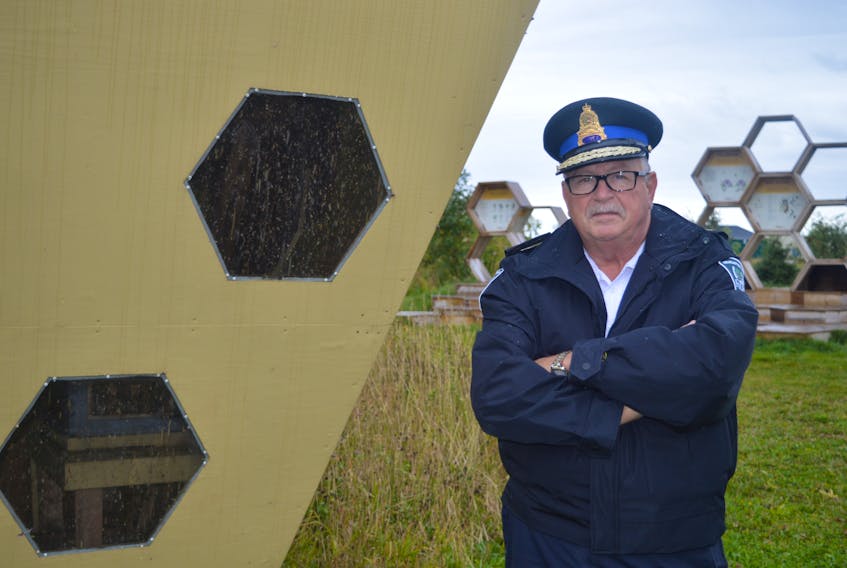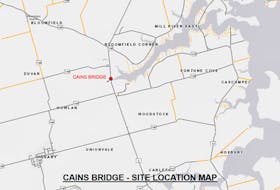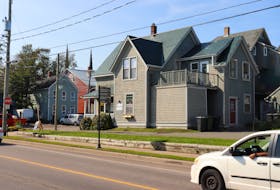CHARLOTTETOWN, P.E.I. — Charlottetown city council may cause quite a buzz with a potential bylaw amendment.
First reading was given this past week to an amendment that would see the definition of livestock in the city’s nuisance bylaw include bees.
Essentially, it boils down to the fact that no one living in an R1 residential area will be allowed to have beehives.
The city did the same thing with chickens and other poultry a few years back.
The nuisance bylaw falls under the city’s protective and emergency services committee and, ultimately, Charlottetown Police Services.
“This is just to kind of prohibit people from sticking beehives in the backyard in residential areas,’’ said Charlottetown police Chief Paul Smith.
There would be a number of properties exempt from this bylaw amendment, such as the Urban Beehive Project that was launched last year behind the P.E.I. Farm Centre on University Avenue.
“I know at one point and time in Ontario . . . you couldn’t put them within 30 metres of the property line (so) that would negate anybody putting them anywhere.’’
One of the reasons the city is doing this is to protect residents.
“It’s just so we’re not having situations of you putting a hive in your backyard and your next door neighbour is allergic to bees. It (comes down) to where you put them. Until (we) get a better handle on what the science of it all is, we don’t want hives popping up in residential neighbourhoods.’’
Exemptions
While the City of Charlottetown is moving to prohibit beehives in residential areas, pending second and final reading next month, the following properties would be exempt:
- Any undeveloped existing parcel of land in a residential zone that is not less than 100 metres in width and 2.45 acres in size
- UPEI
- Atlantic Veterinary College
- Federal government’s Experimental Farm
- Red Shores
- Old Home Week exhibition
- Areas identified as resting places for horse and carriage tours
- Property of the P.E.I. Humane Society
- Premises of an accredited veterinary facility under the supervision of a veterinarian licensed pursuant to the Veterinary Professions Act
- Any area lawfully used for a travelling show, petting zoo, other like shows, parades, festivals or events
- Any area lawfully used as a zoo
Coun. Bob Doiron, who chairs the protective and emergency services committee, agrees that it comes down to the safety factor.
“It was brought up by our police chief. There were concerns to him,’’ Doiron said. “It was just determined by our committee that we didn’t want to have beekeepers within the city.’’
Smith adds that until more is known about the science of bees and their flight path it is better to err on the side of caution.
He said police haven’t received any complaints about residents who have beehives, but they have fielded lots of inquiries from people asking if they can have hives on their properties.
“Until we get a handle on the science a little bitter let’s put something in to say here’s where you can have them,’’ the chief said.
Smith said he’s not aware of any residential home owners who currently keep hives. Anyone who does would be asked to move them.

Nothing to be afraid of
Bruce Smith, a beekeeper in Morell, said he can appreciate what the city is doing but also stresses that bees are nothing to be afraid of. He adds that people need to keep in mind how vital bees are to the environment. They pollinate fruit, produce honey and are major contributors to P.E.I.'s apple and blueberry production.
“It seems a shame when bees are so valuable that they would be trying to limit them,’’ Smith said. “It seems to go against what’s happening in other cities where they’re encouraging people to have beehives on the tops of buildings.’’
Smith does what he can to help educate Island school children about bees, giving talks to classes at the Urban Beehive Project.
“I’ll bet we’ve had a dozen classes out there. We’ve put together a theatrical skit where the kids can pretend they are various types of bees . . . when they play the roles they understand what is going on . . . and how important bees are as pollinators. The big thing is to reduce the fear of bees.’’
Smith said a bee knows it will die if it stings a person and will only do so as a last resort, “so don’t swat at them."
Silva Stojak with Nine Yards Studio in Charlottetown, which designed the hexagon bee houses at the Urban Beehive Project, said it makes perfect sense to prevent beehives from being located near daycares and residents who are deathly allergic to stings but she wonders how far the bylaw would go.
“We produce these little bee hotels, houses for solitary bees that you can put in your garden,’’ Stojak said. “Would they actually prevent that? Then you are definitely not helping the bee population.’’
The bylaw amendment will require a second and final reading, likely to happen at the October monthly meeting.
Beekeeper to give demonstration in Charlottetown Sept. 15 as part of P.E.I. Open Farm Day
People can get up close and personal with thousands of bees on Sunday as part of P.E.I. Open Farm Day in Charlottetown.
Bruce Smith, a beekeeper in Morell, will be giving a demonstration at the Urban Beehive Project behind the P.E.I. Farm Centre on University Avenue at 1 p.m.
“We’ll be talking about the importance of bees and the various stages of life,’’ Smith said. “People can get to within an inch of working bees and not get stung.’’
The Urban Beehive Project features two 14-foot-high hexagon houses. Each of them houses about 60,000 bees. The houses have plexiglass that people can peak through to see the bees at work. There is also a large seating area designed like honeycombs.
The bees can also easily be seen flying in and out of the structures and, if it’s quiet enough, they can be heard buzzing inside.
Smith conducts demonstrations for school children at the Urban Beehive Project, teaching them how important they are to the environment and that there’s nothing to be afraid of.
“You can walk up to the front of those hives and if you’re not being aggressive (such as swatting at them) they just keep flying in and out. They’re not at all concerned about you.’’
Besides insecticides, veroa mites and small hive beetles, a bee’s biggest concern is the wasp. Soldier bees will sit in a row at the entrance to a hive to defend it against wasp invaders.
The Urban Beehive Project was designed by Nine Yards Studio in Charlottetown and built by carpenter Brodie Chappell. The studio received national recognition from the Royal Architectural Institute of Canada for the project. It also received a medal under the community initiative category at the 2018 National Urban Design Awards.
“The innovative Urban Beehive Project shows how urban design can help address, educate and inspire people to protect and conserve the environment,’’ the Urban Design Awards jury said. “It is a model for the role of architecture in starting a dialogue on a locally important environmental issue. In addition to the design and building of playful and engaging forms, the project exhibits the expanded role of the designer (in a non-profit capacity) as steward and educator.’’









